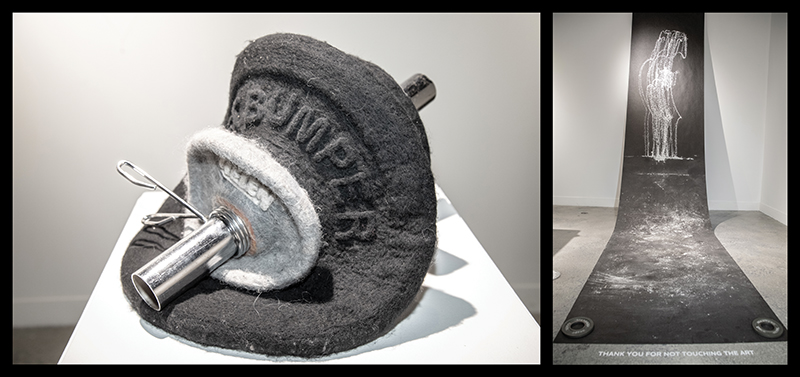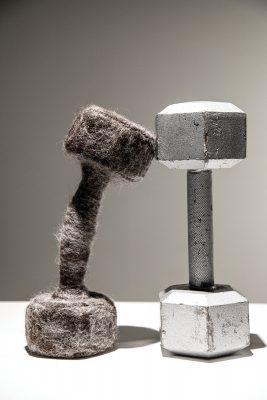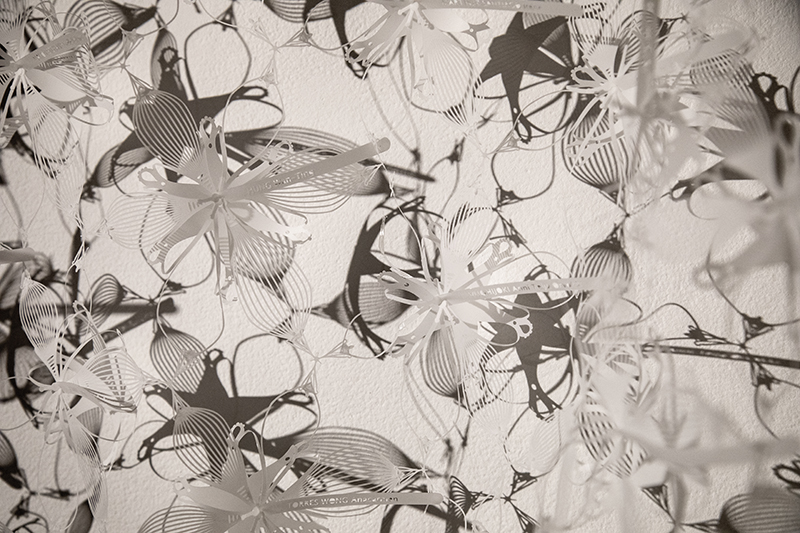
Heavy Lifting: Works by Molly Morin
Art
Information Density, currently on display at UMOCA, is a visual narrative of Molly Morin’s lived experience in the world of competitive weightlifting and coaching, enlightened by her artistic background in sculpture. Viewers are gently led out of perceived notions about sporting and strength through steel encounters, woolly sculptures of equipment and delicate, digital renditions of data. More than a simple metaphor of hard and soft, Morin ruminates deeply on gendered systems, power and control, and the continued struggle for representation in athletics. Both tactile and cerebral, Information Density reflects on corporeal movement and the complex coding that drives it.

The small nook where Information Density is displayed at UMOCA is well lit, not laden despite the (at times literally) heavy subject matter. The pieces range in scale and texture from intricate and repetitive patterns to lumbering blocks of steel. Color is used sparsely yet triumphantly in hues that mirror physical activity. Morin uses graphic allegories to analyze the link between human capability and the propulsion of momentum. Though some of the commentary, by comparison, is forthright—buoyant versus weighted, gossamer versus felted, white versus black—other interactions are more nuanced and intimate. The ethereal mapping of internal body systems—superimposed with visceral, chalk hand markings—calls to question the relationship between technologies and vulnerable human actions. As Morin seems to point out, the athletic human body is as much sacred geometry as it is exertion of force.
In Powers and Pull, Shrug, Power, Jerk, Morin presents enormous, sloping canvases of dark tar paper covered in white chalk marks, drawn with a barbell during training. One can picture a weightlifter standing at the base, grunting as they lift upward to “paint” with their equipment. The resulting imagery is a repetitive sweeping and swirled form, almost as if written in cursive. The beautiful intentionality of the marks resonate even more loudly when one can also see the dust of the chalk floating through the room, recalling the momentum and muscle required to create the piece.
2 x 15 displays a steel and a wool dumbbell on a pedestal—the latter made in the style of soft sculpture, an old German technique popular with artists such as Yayoi Kusama. The soft representation is fibrous and dense, leaned up against the freestanding steel. The sets of equipment seem to support rather than oppose each other, each appearing gritty and material in their own right. The duality can be interpreted many ways, but the technique used serves to remind that physical clout is more than brute force—in fact, it’s multi-dimensional. This concept is revisited in 3 x 10, in which wool felt is attached to a steel dumbbell handle. The felt portion is floppy and malleable while the handle seems rigid and useless when placed in this out-of-context manner. Similarly, Hang uses wool felt in place of a portion of the chain hanging from an iron kettle bell. The play between tool and human in these works is not only a punchy visual metaphor, but it reinforces Morin’s questioning of systems of power.

A wall of the exhibit is dedicated to a series of “training day” images. These colorful and geometric graphics are captures of weightlifters training, created by a machine drawing. Morin uses rich cranberry and indigo-pigmented ink colors reminiscent of the bloodstream to emphasize the human element of the works. Impossibly detailed and architectural, the series is inquisitive and animated. The line between the technological and the individual is crossed back and forth here, ultimately referencing back to the gesture of the weightlifting sport.
The most outstandingly poetic pieces of Information Density are those found in Every Attempt 1998 and Every Attempt 2017. Hanging from the ceiling in white cascades like cutout paper snowflakes, the patterns represent the results for the women’s competition at the respective International Weightlifting Federation World Championships. The works also symbolize certain ranges of weight classes being introduced and then finalized in the IWF. Despite a nearly 20-year gap, the technological (and one could argue, cultural) information gathered is mostly unchanged. Generated via plotter-cut Mylar, both sets of forms are 3D and floral-shaped. An initial, overarching sense of femininity is quickly matched with a closer look at the material, which is a firm plastic that could easily withstand force. Though the weight-class achievement may have been short-lived, the data marches on.
Morin’s works are grounded in the sport and spirit of weightlifting but suspended in the relevance of humans maneuvering through their internalized circuitry. Her art points out the disparaging differences between the two, but it does not neglect to take note of the undeniable sinews that bind them. Through exacting observations and imaginative calculations, Information Technology makes light work out of heavy lifting.
Visit Information Density and other local artist exhibits at UMOCA (20 S. West Temple) through Jan. 12, 2019. For hours and more information, visit utahmoca.org.